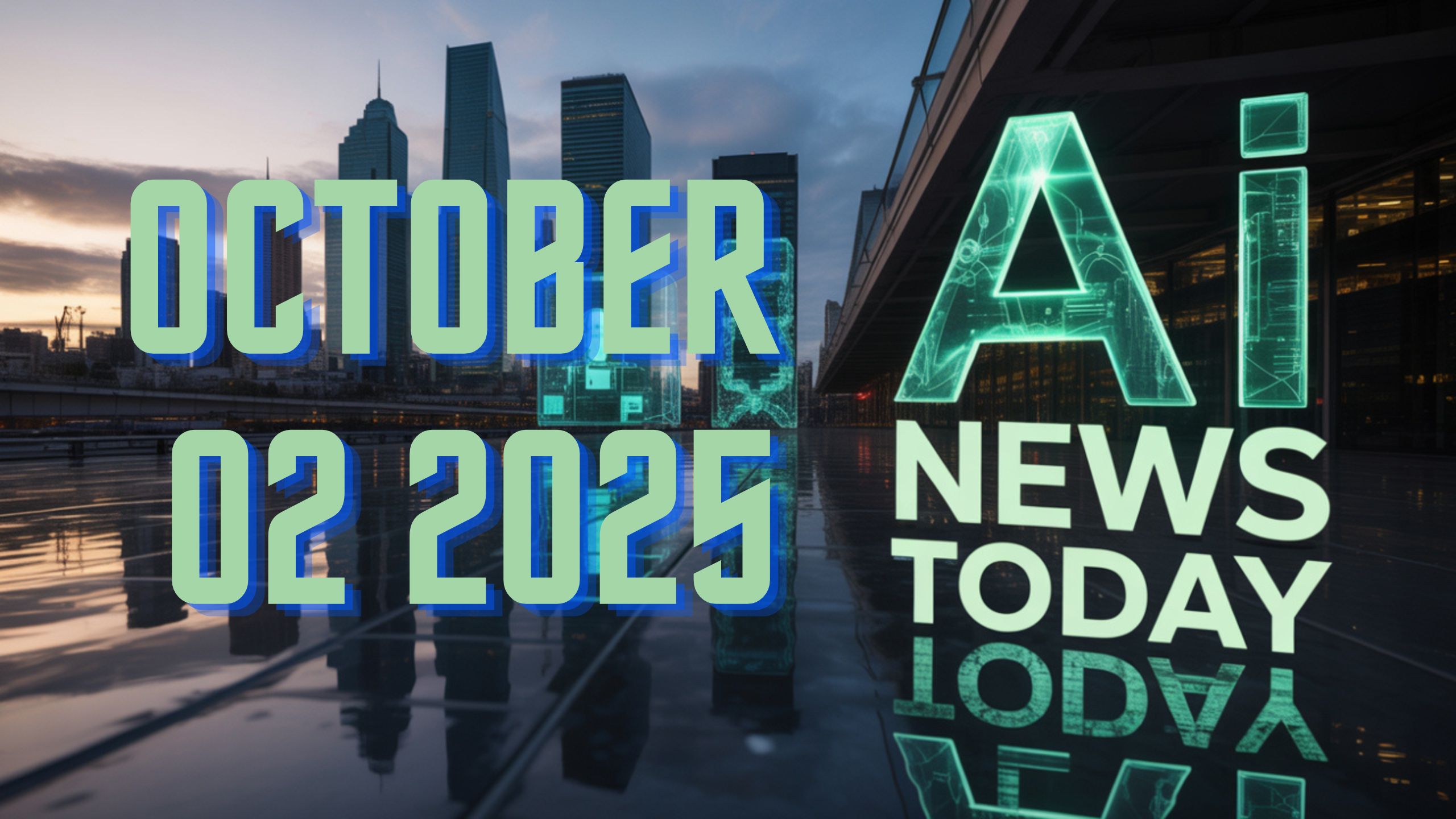AI News Daily — USA (Thursday, October 2, 2025)– The artificial intelligence (AI) ecosystem in the United States continues to accelerate, with enterprise agentic AI adoption, federal policy priorities, IPO signals, and infrastructure expansions shaping the landscape. Today’s AI Daily roundup brings together the most significant developments from across technology, labor, governance, and capital markets.
Kyndryl Launches Advanced Agentic AI for US Enterprises
Kyndryl, one of the world’s largest IT infrastructure providers, has unveiled its next-generation agentic AI solutions designed to scale AI-native enterprise operations. This launch positions agentic AI as a near-term revenue driver and efficiency catalyst across US industries, delivering measurable cost savings and automation potential.
Agentic AI surpasses traditional automation by enabling autonomous decision-making systems that seamlessly integrate into enterprise stacks. Early adopters across various sectors, including finance, healthcare, energy, and manufacturing, are already reporting significant productivity gains. For businesses seeking to remain competitive in 2025, agentic architectures are becoming the standard, embedding AI-driven agents directly into workflows and enterprise platforms.
This rollout aligns with reports forecasting that agentic systems will dominate enterprise AI adoption over the next three years, reshaping how organizations manage operations, customer experience, and workforce deployment.
Labor Market Impacts: Mixed Signals in Generative AI Adoption
The ongoing debate about AI’s role in labor markets intensified this week with the release of a study by the Yale Budget Lab. The findings reveal that, so far, generative AI has not displaced jobs at the economy-wide level—even in roles labeled as “high exposure.” Contrary to executive warnings of mass layoffs, macroeconomic data indicate no measurable decline in employment associated with the adoption of generative AI.
However, at the firm level, the picture looks different. CEOs are increasingly candid about their plans to reduce entry-level hiring as agentic AI systems mature. Many organizations expect that roles in administration, content generation, and basic analytics will shrink as workflows become automated.
This highlights a critical divergence: macro-level stability versus micro-level disruption. While the national labor market appears resilient today, long-term monthly tracking will determine whether adoption eventually shifts workforce demand toward AI-augmented skills rather than traditional entry-level tasks.
Stargate Buildout: First US Campus Goes Live
The Stargate AI infrastructure initiative reached a milestone this week as Crusoe Energy confirmed its Abilene, Texas, campus is now live. The site currently operates two AI-optimized buildings, with six additional facilities under construction.
The $ 400 billion+ Stargate expansion project aims to deliver 10 gigawatts of compute capacity across the US. Future development is already underway in Milam County, Texas, and Lordstown, Ohio, both of which are designated as major scaling hubs.
With hyperscale AI training and inference workloads demanding unprecedented energy and interconnection resources, the Stargate network is quickly becoming a cornerstone of the national AI compute backbone. Analysts note that the project is expected to reshape the competitive balance of global AI infrastructure, ensuring that US firms remain ahead in training next-generation foundation and agentic models.
Copyright and Platform Governance: Disney vs. Character.AI
The intersection of intellectual property (IP) and AI-generated content entered a new phase as Disney issued a cease-and-desist order to Character.AI. The dispute centers around unauthorized use of Mickey Mouse, Marvel, and Star Wars characters in chatbot applications.
This escalation signals a broader shift: rights holders are no longer tolerating AI-based infringements. With publishers and entertainment studios increasingly concerned about AI-generated derivatives, platforms face rising pressure to enforce stricter governance and compliance frameworks.
For developers and platforms, this case highlights the need to strike a balance between creative AI deployments and robust legal safeguards. Industry watchers anticipate an increase in lawsuits and regulatory actions in the coming months as IP holders establish clear boundaries for AI systems.
IPO and Capital Market Signals in the AI Ecosystem
Capital markets are showing renewed interest in AI, with multiple firms moving toward public listings. According to Reuters, Dataiku has engaged banks for a US IPO, while DeepL is weighing a similar listing.
These moves highlight the pipeline of AI-native firms testing investor appetite, following record private valuations and the pressing need for financing hyperscale infrastructure. IPO readiness signals both confidence in AI’s long-term growth trajectory and an evolving capital strategy to fund massive compute investments required for scaling foundation and agentic models.
If these listings succeed, analysts expect a domino effect across the AI sector, with mid-to-late-stage startups accelerating plans to tap into public equity markets.
Federal Priorities and Export Controls: AI and Quantum in Focus
The US Administration’s AI Action Plan continues to emphasize three key priorities:
- Agency adoption of AI systems for government operations.
- Development of evaluation standards to ensure transparency, trust, and performance.
- Workforce programs to prepare employees for AI-augmented roles.
In addition, AI and quantum technologies have been reaffirmed as top FY27 R&D funding priorities, reflecting their strategic importance to national competitiveness.
Export-control vigilance remains a cornerstone of US policy, with advanced AI chips and compute systems under close monitoring to safeguard national interests. As global competition intensifies, these measures are designed to limit adversarial access to high-performance AI training hardware while enabling domestic innovation.
The Strategic Threads Driving AI in the USA
From enterprise adoption to federal regulation, several live threads continue to define the trajectory of AI in 2025:
- Agentic AI in enterprise stacks: transforming workflows and cost structures.
- Labor Market Impacts: Revealing Tensions between Macroeconomic Resilience and Firm-Level Restructuring.
- Stargate infrastructure buildout: powering the next era of compute at massive scale.
- Copyright and governance battles: shaping how platforms manage IP rights in generative systems.
- Capital market openings: signaling maturity and confidence in the sector.
- Federal AI Priorities: Balancing Domestic Adoption with Export Security.
Together, these dynamics illustrate an ecosystem evolving at breakneck speed, where technology, regulation, and economics converge to define the next chapter of AI in America.
Conclusion: The Next Phase of AI Acceleration
The developments of October 2, 2025, underscore a transformative moment for the US AI industry. As agentic AI enters enterprise stacks, infrastructure like Stargate scales to national levels, and policymakers prioritize AI adoption, the groundwork is being laid for a multi-trillion-dollar AI economy.
At the same time, challenges around labor transitions, IP enforcement, and capital access must be addressed to ensure sustainable growth and responsible innovation. As these forces converge, the United States is positioned to remain a global leader in AI advancement, shaping not just markets but also the governance frameworks that will guide this powerful technology into the future.
AITeam is the dedicated editorial team of Android Infotech, consisting of experts and enthusiasts specialized in Android-related topics, including app development, software updates, and the latest tech trends. With a passion for technology and years of experience, our team aims to provide accurate, insightful, and up-to-date information to help developers, tech enthusiasts, and readers stay ahead in the Android ecosystem.
For more about our team, visit our About Us page.




Leave a Reply